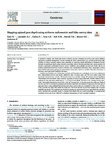Mapping upland peat depth using airborne radiometric and lidar survey data
| dc.contributor.author | Gatis, N | |
| dc.contributor.author | Luscombe, D | |
| dc.contributor.author | Carless, D | |
| dc.contributor.author | Parry, L | |
| dc.contributor.author | Fyfe, R | |
| dc.contributor.author | Harrod, T | |
| dc.contributor.author | Brazier, RE | |
| dc.contributor.author | Anderson, K | |
| dc.date.accessioned | 2018-08-13T07:50:45Z | |
| dc.date.issued | 2019-02-01 | |
| dc.identifier.issn | 0016-7061 | |
| dc.identifier.issn | 1872-6259 | |
| dc.identifier.uri | http://hdl.handle.net/10026.1/12012 | |
| dc.description.abstract |
A method to estimate peat depth and extent is vital for accurate estimation of carbon stocks and to facilitate appropriate peatland management. Current methods for direct measurement (e.g. ground penetrating radar, probing) are labour intensive making them unfeasible for capturing spatial information at landscape extents. Attempts to model peat depths using remotely sensed data such as elevation and slope have shown promise but assume a functional relationship between current conditions and gradually accrued peat depth. Herein we combine LiDAR-derived metrics known to influence peat accumulation (elevation, slope, topographic wetness index (TWI)) with passive gamma-ray spectrometric survey data, shown to correlate with peat occurrence, to develop a novel peat depth model for Dartmoor. Total air absorbed dose rates of Thorium, Uranium and Potassium were calculated, referred to as radiometric dose. Relationships between peat depth, radiometric dose, elevation, slope and TWI were trained using 1334 peat depth measurements, a further 445 measurements were used for testing. All variables showed significant relationships with peat depth. Linear stepwise regression of natural log-transformed variables indicated that a radiometric dose and slope model had an r2 = 0.72/0.73 and RMSE 0.31/0.31 m for training/testing respectively. This model estimated an area of 158 ±101 km2 of peaty soil >0.4 m deep across the study area. Much of this area (60 km2) is overlain by grassland and therefore may have been missed if vegetation cover was used to map peat extent. Using published bulk density and carbon content values we estimated 13.1 Mt. C (8.1–21.9 Mt. C) are stored in the peaty soils within the study area. This is an increase on previous estimates due to greater modelled peat depth. The combined use of airborne gamma-ray spectrometric survey and LiDAR data provide a novel, practical and repeatable means to estimate peat depth with no a priori knowledge, at an appropriate resolution (10 m) and extent (406 km2) to facilitate management of entire peatland complexes. | |
| dc.format.extent | 78-87 | |
| dc.language | en | |
| dc.language.iso | en | |
| dc.publisher | Elsevier | |
| dc.subject | Gamma-ray attenuation | |
| dc.subject | LiDAR | |
| dc.subject | Remote sensing | |
| dc.subject | Peat depth | |
| dc.subject | Soil organic carbon | |
| dc.subject | Peatland | |
| dc.title | Mapping upland peat depth using airborne radiometric and lidar survey data | |
| dc.type | journal-article | |
| dc.type | Journal Article | |
| plymouth.author-url | https://www.webofscience.com/api/gateway?GWVersion=2&SrcApp=PARTNER_APP&SrcAuth=LinksAMR&KeyUT=WOS:000447095700008&DestLinkType=FullRecord&DestApp=ALL_WOS&UsrCustomerID=11bb513d99f797142bcfeffcc58ea008 | |
| plymouth.volume | 335 | |
| plymouth.publication-status | Published | |
| plymouth.journal | Geoderma | |
| dc.identifier.doi | 10.1016/j.geoderma.2018.07.041 | |
| plymouth.organisational-group | /Plymouth | |
| plymouth.organisational-group | /Plymouth/Admin Group - REF | |
| plymouth.organisational-group | /Plymouth/Admin Group - REF/REF Admin Group - FoSE | |
| plymouth.organisational-group | /Plymouth/Faculty of Science and Engineering | |
| plymouth.organisational-group | /Plymouth/Faculty of Science and Engineering/School of Geography, Earth and Environmental Sciences | |
| plymouth.organisational-group | /Plymouth/REF 2021 Researchers by UoA | |
| plymouth.organisational-group | /Plymouth/REF 2021 Researchers by UoA/UoA14 Geography and Environmental Studies | |
| plymouth.organisational-group | /Plymouth/Research Groups | |
| plymouth.organisational-group | /Plymouth/Research Groups/Marine Institute | |
| plymouth.organisational-group | /Plymouth/Users by role | |
| plymouth.organisational-group | /Plymouth/Users by role/Academics | |
| dcterms.dateAccepted | 2018-07-27 | |
| dc.rights.embargodate | 2018-8-14 | |
| dc.identifier.eissn | 1872-6259 | |
| dc.rights.embargoperiod | Not known | |
| rioxxterms.funder | Natural Environment Research Council | |
| rioxxterms.identifier.project | South West Partnership for Environment and Economic Prosperity (SWEEP) | |
| rioxxterms.version | Version of Record | |
| rioxxterms.versionofrecord | 10.1016/j.geoderma.2018.07.041 | |
| rioxxterms.licenseref.uri | http://www.rioxx.net/licenses/all-rights-reserved | |
| rioxxterms.licenseref.startdate | 2019-02-01 | |
| rioxxterms.type | Journal Article/Review | |
| plymouth.funder | South West Partnership for Environment and Economic Prosperity (SWEEP)::Natural Environment Research Council |


